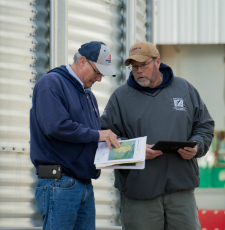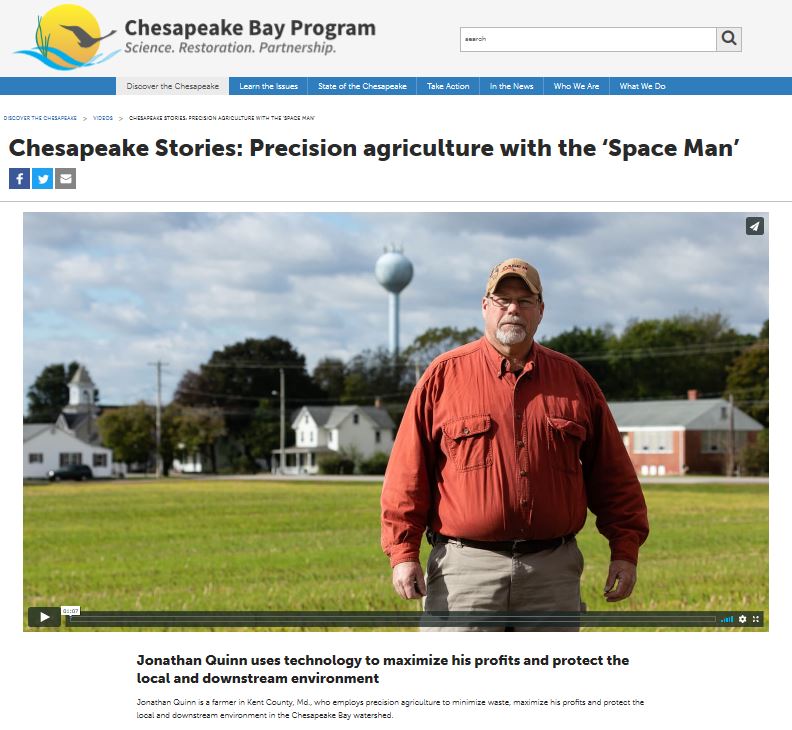MD Farmer Jonathan Quinn selected as 2019 4R Advocate
 It’s no surprise that one who leads a fifth-generation farm might also be an early adopter. Jonathan Quinn was one of the first in the Delmarva region to invest in a yield monitor. He also incorporated the 4Rs before they were so named. It comes naturally. His father was conducting annual soil tests in the 1960s. They still do. Little Bohemia Creek Farms now covers 2,350 acres in the Chesapeake Bay Watershed and includes corn, soybeans, wheat, barley, and spinach, as well as a custom farming business.
It’s no surprise that one who leads a fifth-generation farm might also be an early adopter. Jonathan Quinn was one of the first in the Delmarva region to invest in a yield monitor. He also incorporated the 4Rs before they were so named. It comes naturally. His father was conducting annual soil tests in the 1960s. They still do. Little Bohemia Creek Farms now covers 2,350 acres in the Chesapeake Bay Watershed and includes corn, soybeans, wheat, barley, and spinach, as well as a custom farming business.
Though Maryland law requires nutrient management plans be filed for every acre on the farm, they’re not new to Quinn. He and his crop advisor, Kenny Glenn with Southern States Cooperative in Middletown, Delaware, have used 4R strategies in the plans since the beginning. In fact, they’ve worked together for 20 years to continually improve the farm and community.
“Even when we voluntarily compiled nutrient management plans, we found we didn’t need all the nutrients we were applying,” Quinn says. “We’ve gotten better since.”
In addition to 4R practices, technology helps. GPS, autosteer, the yield monitor, a 16-row, variable-rate planter, 30’ air seeder, and variable-rate sprayer are supplemented by satellite field imagery and soil maps.
Pre-sidedress nitrate tests, tissue samples, and fall nitrate tests help guide in-season nitrogen applications. UAN is variable-rate injected, even in sidedress applications, and Avail phosphorous enhancer and NutrisphereN help ensure they’re available to the crop when needed. Cover crops help retain nutrients through winter.
It pays off. Corn and soybean yields are up five to 10 percent, while nutrient application remains optimal for soil and crop health. If these 4R practices work for the Chesapeake Bay Watershed, they’ll work anywhere.
Best Practice Management
- Annual grid and soil sampling guide nutrient management plan to focus only on what nutrients are needed.
- Nutrient management plan determines how much N, P, and K are needed.
- Pre-sidedress and fall nitrate tests help determine in-season nitrogen applications.
- Injected UAN reduces volatilization.
- Variable-rate nutrient application ensures crops get the right amount of nutrients.
- GPS-precision nutrient applications helps soils that need additional nutrients get the right ones.
- Variable-rate sprayer delivers the exact amount of product needed.
- Cover crops retain nutrients.
- Conservation practices include cover crops, no-till, grassed waterways, riparian buffers, wildlife habitat, an agricultural chemical handling facility, and a manure storage building.
Jonathan was also featured on the Chesapeake Bay Program’s website for his advanced nutrient management practices:
You can read about all of the 2019 4R Advocates at nutrientstewardship.org
